The Bolitho war memorial window at St Pol de Léon Parish Church, Paul, Cornwall
This article is based on a presentation at Paul Parish Church on , given to launch the appeal for the restoration of the Bolitho memorial window.

Figure 1. The Bolitho war memorial window.
Photograph copyright © Peter Hildebrand
High-resolution image will start to load shortly …
The fine 15th-century tower of Paul parish church overlooking Mount’s Bay has been used for navigation purposes for centuries of navigators and seafarers. The interior of the church is dominated by the 20th-century five-light war memorial window above the High Altar in the chancel1 (Figure 1). There are 25 – war memorial windows in Cornish parish churches, but this one is unique in its avoidance of the usual Saints Michael and George symbolic figures and its emphasis on the personal history of its dedicatee. I do not know of another such example in the whole of the South West: such a unique window is of the highest artistic and historic significance, and must rank as one of the most important stained glass windows in Cornwall of any age.2
The window was donated by the Bolitho family in memory of Lieutenant William Torquill Macleod Bolitho, who died on at Château Hooge, in the second battle of Ypres, and another seven dedicatees were added in the adjacent memorial tablet (Figure 19). In the previous year, the family had donated a window in the south aisle of St John the Baptist, Leusdon, Devon, also in memory of Lt William Bolitho, which contains many of the same themes as this window.
The Bolitho memorial was designed by Robert Anning Bell (–). The maker’s mark is dated , although the actual Faculty was not granted until .4 and the window was dedicated in the church on .9. Robert Anning Bell was one of the leading Arts & Crafts artists of the first decades of the 20th century. He was a highly respected artist, mosaic designer (including mosaics at Westminster Cathedral and the Palace of Westminster) and stained glass designer. From to he was at the Glasgow School of Art as teacher, lecturer and ultimately Director of Studies in its School of Design & Crafts.5 Anning Bell’s design for this Bolitho window was executed by The Glass House of Lowndes & Drury.
Without any doubt, this window eloquently expresses the personal grief and loss felt by one of the most important families of Cornwall, in images that are completely different to the usual symbols and iconography employed in memorial windows of the First World War.

Figure 2. The five main panels.
High-resolution image will start to load shortly …
The overall design of the window strikingly contrasts the rich colours of the main panels with the use of mostly white glass in the surrounding lights (Figure 2). Philip Webb employed a similar technique in many of his earlier designs for William Morris, notably in his Chancel east window at Ladock in .6
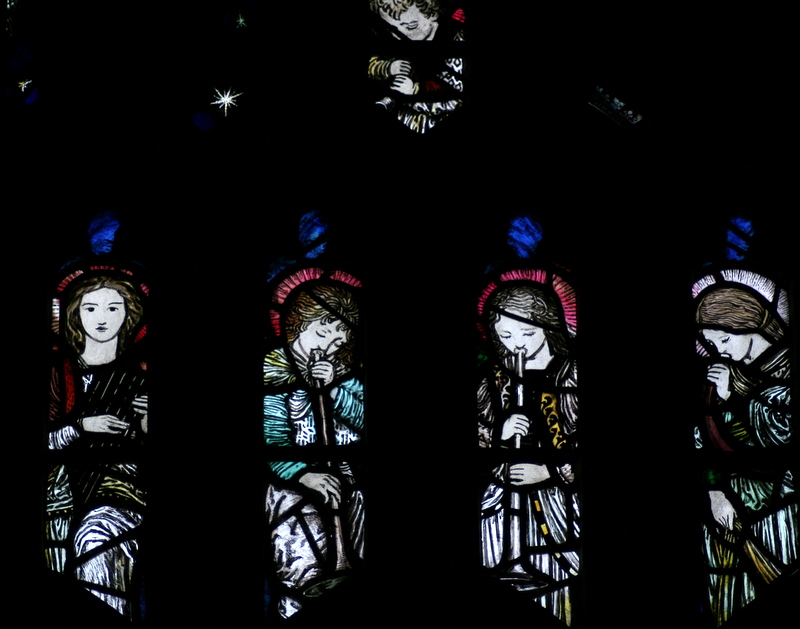
Figure 3. Tracery lights: angels playing musical instruments.
Starting at the top of the window, there are eleven sections in the tracery. Each is occupied by very young angels playing musical instruments, which include long trumpets (similar to Burne-Jones’ designs), lutes, cymbals, harp and other assorted medieval brass instruments (Figure 3). The very youthful angels are typical Anning Bell designs of great charm, the innocence of their celestial choir making a telling contrast with the realities of the World War Ⅰ battlefield below. One is reminded of Louis Davies’ memorial window at Michaelstow, where similar child images are used for the attendant angels.



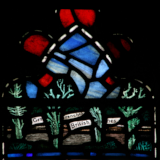

Figures 4–8. Heads of the five main lights, showing the battlefield at Château Hooge:
- Figure 4. Ypres Menin Road. German Trenches. British Trenches.
- Figure 5. Ecluselte Cottage.
- Figure 6. Bellewarde [sic] Wood.
- Figure 7. German Trenches. British Trenches.
- Figure 8. Hooge. Ypres Menin Road.
Larger version 4006 × 830.
Turning to the main part of the window, the heads of all five lights are a depiction of the battlefield at Château Hooge, the scene of the death of the main dedicatee, with the roads (Ypres to Menin), buildings, woods and the disposition of the British and German trenches all labelled clearly (Figures 4–8). Such a detailed and graphic depiction of a World War Ⅰ battlefield in a memorial stained glass window is unique in the South West.

Figures 9–11. The inner three main lights showing Lt Bolitho, as Sir Galahad, being received by twelve angels.
Photograph copyright © Peter Hildebrand
High-resolution image will start to load shortly …
The three inner main lights are panels depicting the reception by eleven angels of the dedicatee (in a photographic likeness) as Sir Galahad. In the central panel, he is leading a horse and holding a spear (Figure 10). He is attended on either side in the adjacent lights by a hierarchy of mature angels, some in martial attire and bearing arms, and youthful angels praying, singing and holding palms (Figures 9 and 11).

Figure 12. The top of the left-hand light, showing the arms of Bolitho above two child angels. The arms illustrate Lt Bolitho’s ancestry and relationship with other Cornish families: on the left (dexter!) Bolitho of Trengwainton, Penzance, is ermine, on a plain chevron between two chevronels engrailed and three fleurs-de-lis sable five bezants (). Borlase is ermine on a bend sable two hands and arms issuing out of the clouds at the elbows all proper rending a horseshoe or (), Trevelyan is gules a demi horse argent hoofed and maned or, issuing out of water in base proper (), On the right is his mother’s family, Macleod of Cadboll (Mackenzie 1889 p 431), quarterly 1st or, a mountain azure inflamed proper, 2nd gules three legs in armour conjoined at the upper part of the thigh proper, 3rd or, a lymphad sable flags gules, 4th azure, a castle triple-towered and embattled argent masoned sable windows and porch gules ().
High-resolution image will start to load shortly …

Figure 13. The top of the right-hand light, showing the badge of the 19th Royal Hussars (Queen Alexandra’s Own) above two child angels.
High-resolution image will start to load shortly …

Figure 14. The centre and bottom of the left-hand light. At the top is a representation of the lakenhalle (Cloth Hall) in Ypres, with the arms of Flanders on the left and Ypres on the right. This medieval commercial building was destroyed by artillery fire during the First World War and then reconstructed over a period of 30 years to its pre-war state. At the bottom are the arms of the Duchy of Cornwall, sable fifteen bezants, five, four, three, two, and one ().
High-resolution image will start to load shortly …
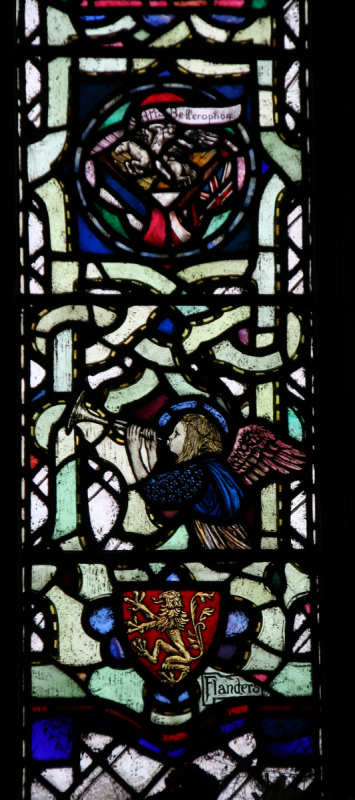
Figure 15. The centre and bottom of the right-hand light. At the top is the emblem of HMS Bellerophon, in which Lt Bolitho served as a midshipman before he joined the army. At the bottom are the arms of Flanders.
High-resolution image will start to load shortly …
The main panels of the first and fifth lights are mostly richly textured Prior’s Early English glass with a complicated knot pattern incorporating the arms of Cornwall, the Bolitho family, Flanders, the 19th Hussars, HMS Bellerophon and a representation of the lakenhalle (Cloth Hall) in Ypres. There are several child angels praying, holding palms or blowing trumpets. The design of these panels reminds us that Anning Bell, like Edward Burne-Jones, had considerable experience in designing mosaic (Figures 12–15).
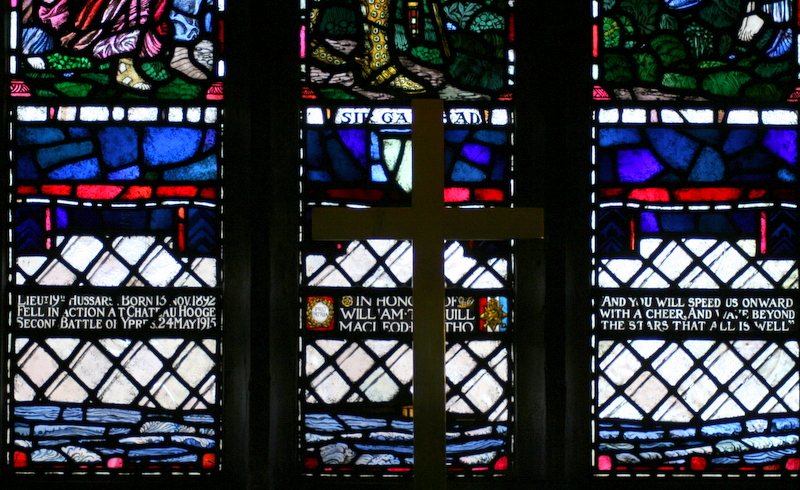
In honour of William Torquill Macleod Bolitho.
Lieut 19th Hussars. Born . Fell in action at Chateau Hooge Second Battle of Ypres. .
And you will speed us onward with a cheer
And wave beyond the stars that all is well
(the last two lines of the the poem
‘Julian Grenfell’ by Maurice Baring
(–)).
Figure 16. The main inscription is below the main panels across the lower parts of lights two to four on textured white glass in diamond leads. To left and right of the central inscription are a Pro Patria emblem and the 1914–15 medal on a red, white and blue ribbon, which Lt Bolitho would have been entitled to wear. The poet Julian Grenfell (–)7 died two days after Lieut Bolitho, of wounds received at Château Hooge thirteen days earlier.

Figure 17. The bottom left-hand corner of the window, showing cliffs and the sea.
High-resolution image will start to load shortly …
Below the inscription across all five lights at the base of the window is a representation of cliffs and the sea. This has been interpreted as the view of the west coast of the Lizard as seen from the churchyard at Paul Parish Church.
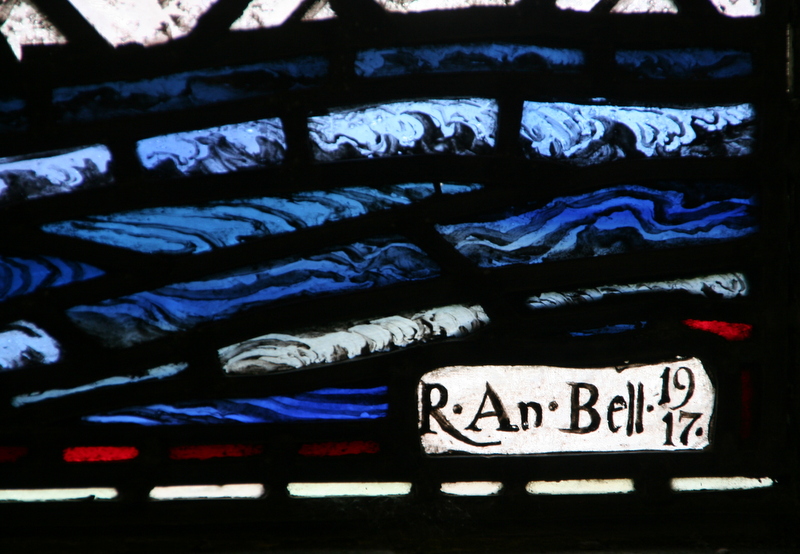
R·An·Bell·.
Figure 18. The mark of Robert Anning Bell, in the right-hand bottom corner of the fifth light.

To gallant men
This window is also in memory of his uncle Lieutenant Torquill Macleod R.N.
H.M.S. Serpent
wrecked off the coast of Spain
and of his cousin Midshipman Torquil Harry Lionel Macleod R.N.
H.M.S. Goliath and his shipmates of the parish of Paul
John Thomas Blewett
Mark Hallo Wallis
Richard Worth Wallis
Charles Everett Richards
William Gilbert Harry
who went down with their ships in the Dardanelles
and in honoured memory of all those who died with them.
Figure 19. The memorial tablet adjacent to the window. In the bottom right-hand corner is inscribed the name of its maker, Peter Wylie Davidson, who was a contemporary of Robert Anning Bell, the maker of the window, at the Glasgow School of Art.
High-resolution image will start to load shortly …
The memorial tablet (Figure 19) adjacent to the window adds seven more dedicatees: Lt William Bolitho’s uncle Lt Torquill3 John Pollard Ross Macleod of HMS Serpent, wrecked off the coast of Spain in , his cousin Midshipman Torquil Harry Lionel Macleod of Invergordon Castle, Scotland, and five men from the parish of Paul who perished in the Dardanelles in .
In summary, this is a most ambitious stained glass design, incorporating a vivid range of imagery and iconography, with consummate technical command of materials and processes. The extent of the personal references to the dedicatee and the contrast between the peaceful coastal scene at the base of the window and the battle scene at the top complete what must rank as one of the most individual war memorial windows of its time. The only window to my knowledge to match it is AJ Davies’ war memorial window at Bradford Cathedral which shares many similarities but was designed in , three years later than Anning Bell’s window.
One month after the granting of the Faculty, Canon RM Paul, Chancellor to the Diocese, wrote the following:
I would therefore like you to discourage the introduction into your church of any individual war tablets and by doing so you may sometimes prevent (inter alia) the rich man’s son having his name prominent whilst that of the poor man’s son is left in obscurity.8
One cannot but wonder at the coincidence of the timing of Canon Paul’s remark and the insertion of the Bolitho window. The passage of one hundred years has softened the raw emotions revealed eloquently in the window, and today we can appreciate equally those emotions and the artistry of the window’s design and manufacture.
References
- Imperial War Museum Register of War Memorials, reference 33593.
- Michael Swift, Stained glass war memorials in Cornwall.
- The window uses the spelling ‘Torquill’ for Lt William Torquill Macleod Bolitho, 19th Hussars (died near Ypres in Flanders). The memorial tablet (Figure 19) in the Chancel uses the spelling ‘Torquill’ for Lt Torquill Macleod RN (died in HMS Serpent off the coast of Spain), and ‘Torquil’ for Mid Torquil Harry Lionel Macleod RN (died in HMS Goliath in the Dardanelles).
- Truro Diocesan Faculty, , .
- Peter Cormack, Arts & Crafts Stained Glass, p 130, Yale, .
- Michael Swift, The Morris windows at St Ladoca, Ladock, Cornwall.
- His poem ‘In Battle’ is in many anthologies of War Poets.
- Truro Diocesan Magazine, , p 110, where Canon Paul’s comments are dated .
- Cornishman and Cornish Telegraph (Newlyn edition; not published in Penzance edition). , p 5.